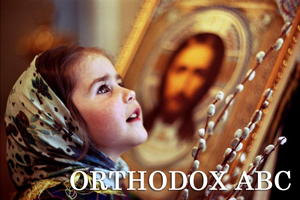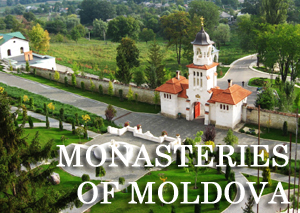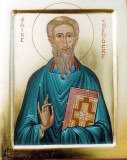
‘I know that though they despised me during my life,
yet after my death they will see that my teachings are
not to be cast aside so lightly’.
St. Cuthbert of Lindisfarne
St. Cuthbert of Lindisfarne, known as ‘the Wonderworker of Britain’, was a seventh-century English hermit and bishop and St. Seraphim of Sarov, preacher of the acquisition of the Holy Spirit, a nineteenth century Russian priest and monk. It might seem extraordinary to those outside the Orthodox Church to compare two such people of different nationalities who lived twelve centuries apart – but it should not.
Both St. Cuthbert and St. Seraphim dwelt and laboured in the selfsame monastic spirit, which has its roots in the Gospels and the Apostles and the Desert Fathers led by St. Antony the Great. From the third, fourth and fifth centuries on, the influence of these Fathers was to spread both south and north, east and west. Going south, their way of life spread down the Nile to Ethiopia and the Sudan. Going east and then north, their ascetic teachings and practices spread to Palestine, to what is now Turkey and Greece, to what is now Armenia, Georgia, Iraq and Iran, later into the Balkans and Russia and ultimately across the Volga into Siberia, Japan, China and Alaska. Going west and then north, they spread to North Africa, Italy and Gaul, to Ireland and the rest of the British Isles, then to Iceland and all Western Europe. Thus the comparison between Russian and English holiness should not seem strange: St. Seraphim and St. Cuthbert, both among the greatest saints of their respective lands, shared the same spirit, that of the Desert Fathers. Indeed had England remained within the Orthodox fold, we would today know St. Cuthbert’s life better than that of St. Seraphim. And thus today we would be writing not of St. Cuthbert the English St. Seraphim, but rather of St. Seraphim the Russian St. Cuthbert. Who then was St. Cuthbert?
He was born in c. 634 in Northern England, in the area of the present Scottish Border. Of noble Anglian birth, at the age of eight he was taken in by a foster-mother Kenswith, a widow and nun. Aged seventeen he became a novice at the monastery of Melrose (now in southern Scotland). With other monks he followed his Abbot and moved to Ripon in Yorkshire to start a new monastery. Later he moved back to Melrose and then to Lindisfarne, an island off the north-east coast of England. On small islands nearby, called St. Cuthbert’s Isle and Inner Farne, he was to live as a hermit. Visitors noised his holiness abroad and in York on Easter Sunday 685, much against his will, he was consecrated bishop by the Greek St. Theodore of Canterbury and six other bishops. He reposed two years later, aged about fifty-three, on 20 March 687. Such is the outer history of St. Cuthbert, but what of his inner history?
From the outset, Cuthbert’s life is permeated by his contact with the other reality, the other world. Rebuked as an eight-year old child for his light-hearted games and pranks, ‘unseemly for a holy bishop’, from this time on he became serious and ‘the Spirit spoke to him in the secret places of his heart’. Visions were granted to him. Once he was healed of lameness by an angel. Another time, when still a shepherd-boy on the Lammermuir Hills and not yet a monk, he saw angels taking heavenward the soul of the great St. Aidan. And as a monk, Cuthbert was to have visions and visitors from the other world. As guestmaster at the monastery of Ripon, he entertained an angel. This miracle did not make him proud, but humbled him and increased his zeal. From then on angels often appeared to him and conversed with him. Virtue and grace grew in him and at the age of thirty he became prior or assistant-abbot at Lindisfarne. After many years, accomplished in the obedience of monastic life and the renunciation of his own will, he received the blessing to live as a hermit on Inner Farne. Here too he had contact with another world, not that of the angels, but that of the fallen angels, the demons who haunted that small island. Often they strived to cast him from a rock into the ocean, or hurled stones at him, or sought to tempt him and discourage him, but they failed to harm him or terrify him. Assailing him, they were defeated by Cuthbert’s prayer and strict fasting. Once these devils had been cast out of the island, angels came and helped the hermit build a cell and chapel. Another time, towards the end of his life, Cuthbert was to see angels taking the soul of a devout monastic servant to heaven.
These visions of the real world, the world of the spirit which runs parallel to this world of illusion, were granted to Cuthbert on account of his humility and piety, expressed in his asceticism. Without prayer and fasting and humble-mindedness, none of this would have been given him. Thus while others slept, by the monastery of Coldingham he was once seen standing the whole night up to his waist in the cold water of the North Sea, prayerfully chanting the Psalter, returning to the monastery in the early morning in time for the first service of the day. He lived the life of the Fathers of the Early Church, as St. Gregory the Great, the Apostle of the English, had recommended to St. Augustine. The first life of Cuthbert, written a few years after his repose, records: ‘He was wonderfully forbearing and his courage in bearing hardship in body and mind was unsurpassed … . Such was his zeal for prayer that sometimes he kept vigil for three or four nights in a row without ever sleeping in his bed. Whether he was praying alone in some hidden place or reciting the psalms, he always did manual work to fight off the heaviness of sleep’. He would spend Great Lent and Advent Lent, both forty days long, in prayer, strict fasting and tears. His lowly spirit is summed up by his attitude to his foreknowledge, given him by St. Boisil (Boswell) the Abbot of Melrose, that one day he would be a bishop. Cuthbert said: ‘If I could live in a tiny dwelling on a rock in the ocean, surrounded by the swell, cut off from the sight and knowledge of all men, I would still not be free from the cares of this fleeting world, nor from the fear that the love of money might yet snatch me away . This life is one which Cuthbert led when he moved to Inner Farne, seven miles across the sea from Lindisfarne. Here, having built a cell and chapel, he surrounded them with a high, circular wall of rough stone and turf, so that all he could see was the sky – this was all that was needful for his spirit.
The grace which Cuthbert acquired through his asceticism was revealed in his pastoral activity. In theological terms, his love of God was followed by the love of his neighbour. As prior at Melrose, Cuthbert gave advice not only to the monks inside the monastery but also to the lay-people who lived around. Often he would visit these surrounding villages, usually on foot, preaching. The people would gather round him to listen to this angel-like monk, confessing every sin to him, not daring to keep anything back, he would know what was in their hearts anyway. He was full of sorrow at sin and could not serve without tears. As penitents spoke of their sins, he would burst into tears of compassion at their suffering and weakness. As a true spiritual father he would himself do penance for them. In his labour of love he would search out even the most rugged places in the hills and would live with the rough folk for up to a month, setting an example of piety and preaching among them. At Lindisfarne he did the same, taking on the role of Elder. By his attitude he inspired all to live as the Christian should. Already a hermit, people came to him, not only from Lindisfarne, but from all over Britain, having heard of his miracles. They confessed to him, spoke of their temptations, seeking consolation. It is written that no-one left unconsoled. He warmed the hearts of the weak, he gave hope to the anxious, spoke of heavenly joy to the disconsolate. He explained the wiles and workings of the devil to those tempted, explained that this world is transitory, all passes and that a soul lacking in love for God or man is always easy prey for the Evil One. And when he was made bishop, he followed the teachings and practices of the apostles, praying for his spiritual flock, giving them first his own example. He gave comfort to all and brought sinners to repentance. He maintained the strictness of the monastery amid the temptations of worldly glory: ‘He fed the hungry, clothed the needy, and had all the marks of the perfect bishop’.As a result of his humble asceticism, Cuthbert acquired many gifts from the Creator. Firstly seeing his obedience to the Creator, the Creator made Creation obedient to Cuthbert: in the Saint was restored the obedience of Creation to Adam, whom Creation had formerly obeyed on account of Adam’s sinless humility: ‘Blessed are the meek, for they shall inherit the earth’. This gift was shown in Cuthbert’s power over the four elements, earth, air, fire, water, and over the animal world. Once he stopped a fire through praying for a change in the direction of the wind, on two occasions he calmed storms at sea and another time the sea obeyed him, yielding him up wood as he needed it. Many times birds and animals obeyed him. Once, fasting on a Friday till the late afternoon, as he was wont, a horse found him half a loaf of bread in the thatch of a house. He gave half of the bread to the horse and took the rest for himself. Another time, after he had prayed all night long in the sea, two sea-otters came to warm his feet and dry him with their fur; they received his blessing. Again, after fasting, a large fish was brought to him by an eagle. The fish was cut in two, half for the eagle, half for a family and himself. ‘Learn to have constant faith and hope in the Lord. He who serves God shall never die of hunger’, said Cuthbert. Another time, when he ordered birds who had come to eat barley he had sown to depart, they obeyed him. Ravens were reproved by him and then later brought him lard as a sign of their repentance. ‘What care should men not take to learn obedience and humility’, he said, ‘when even birds hasten to wash away their faults’.
A second gift for Cuthbert’s gentle humility was the gift of prophecy, and his second sight, knowledge of what was happening at the same time but in another place. So close was he to the Eternal, that he overcame time and space. Once, journeying by boat to Scotland, he and other monks were beleaguered by a storm and had nothing to eat. Cuthbert remained trustful, foreknowing that God would provide. Indeed they found portions of a dolphin to eat, as though they had been prepared for them. Another time he cast demons out of a sheriff’s wife from a distance. Strong in the spirit of prophecy, he foretold Abbess Elfleda (Ælfflæd) that her brother King Ecgfrith would die, that the next king would be Aldfrith and that he himself would become a bishop, but only for two years. Later he was to see in spirit the death of King Ecgfrith. To his soul-friend, the hermit Herbert of Derwentwater, he foretold his own death, saying that their souls would leave their bodies at the same time, ‘that they would go forth together and behold the glory of God’s Mercy in Heaven’.
Another proof of the grace won by Cuthbert was in his miracles which healed many from disease and affliction, including those infected with demons. As a hermit he found water on barren rock, he healed Abbess Elfleda with his belt, he healed with holy water, with holy oil, with blessed bread. By prayer he healed a young man who had been brought to him dying and a boy dying of the plague. His power over the demons was no less significant. Once he stopped a phantom fire which the demons used to frighten the faint-hearted, he banished demons from Inner Farne and again fought them away before his death when they tempted him when for five days he lay ill. Once he changed water into wine. And even on his death-bed he healed a monastic servant. This was only the beginning for his healings and miracles have continued after his death, even to the present day. Thus just as St. Seraphim, born in Kursk, saved Russia through his intercessions at the famous tank-battle of Kursk in 1943, so in 1942 St. Cuthbert, his relics resting in Durham Cathedral, saved that city from the bombs of the Luftwaffe by shrouding the city in thick fog on the night of their raid.
This grace that St. Cuthbert won did not leave his body with his soul. After his repose everything that belonged to him was touched by grace, be it his shoes which healed a paralytic, a calf-skin which healed the hermit St. Felgild, or even soil from where the relics of the saint of God had lain. Eleven years after his repose in 698, when the monks of Lindisfarne were prompted to open St. Cuthbert’s coffin, they found the relics intact, the body looked alive, even the saint’s vestments looked new. The monks were instructed by Bishop Edbert to put new vestments on the relics in place of those that they had taken off, saying: ‘See how is honoured the form of an earthly body, foretokening the much greater glories to come! Thou Lord hast brought forth might from these dear bones of Cuthbert, filling the Church with the very air of Paradise’.
Having then related something of the life of St. Cuthbert, the reader might well wonder how all this was possible. Why were such extraordinary gifts granted to Cuthbert? The answer we find in the Life of the Saint written shortly after his repose. Speaking of the healing at a distance of the sheriff’s wife from a demon, it is written that Cuthbert was ‘filled with the Holy Spirit’ and that this was why, sensing Cuthbert’s prayer, the demon was forced to leave the woman, being unable to bear the Saint’s approach. Again, in all the difficulties Cuthbert faced in the coenobitic life with other monks, it is written that, ‘it was clear to all that it was the Holy Spirit within that gave him strength to smile at attacks from without’. Like St. Seraphim, St. Cuthbert too had ‘acquired the Holy Spirit’, the same Holy Spirit, borne by the Church of God, Who indwells in all the faithful, uniting all ages, cultures and lands.
‘Save yourself and thousands around you will be saved’, said St. Seraphim of Sarov. It is not difficult to hear St. Cuthbert saying the same. In England and Scotland some eighty-three churches were to be dedicated to St. Cuthbert, making him the most popular native Saint. And after St. Cuthbert, Lindisfarne was to be called ‘Holy Island’, becoming the Athos of England. Its holy Abbots succeeded one another: St. Aidan, St. Finan, St. Colman, St. Eata, St. Cuthbert, St. Edbert, St. Edfrith, St. Ethilwald. Here in honour of St. Cuthbert St. Edfrith wrote, and St. Billfrith the hermit adorned, the Lindisfarne Gospels, magnificent treasure of Christendom, with their portraits of the four Evangelists, their names written in Greek in Latin letters(1). And when in 1104 St. Cuthbert’s relics were translated, a still surviving seventh-century copy of the Gospel of St. John was found lying on an inner lid of the coffin – it may well have been St. Cuthbert’s own. When in 1827 St. Cuthbert’s relics were examined again, the coffin lid was found to depict Christ with the symbols of the four Evangelists. The sides of the coffin were adorned with the Twelve Apostles, five Archangels and the Holy Mother of God. Inside were the holy relics, together with a wooden altar-top, a bone-comb, silks from Constantinople and Persia, a stole embroidered in the Eastern Roman style by devout English ladies in the tenth century, and St. Cuthbert’s own pectoral cross, with at its centre a shell from the Indian Ocean.
Monastic life has never been restored at Lindisfarne since the Viking onslaught of 794. And today Holy Island with St. Cuthbert’s Isle and Inner Farne, now a bird sanctuary, with their cormorants and cliffs, seals and gannets, stormy seas and eider duck, still today called St. Cuthbert’s duck, are the only visible remains of that place where once St. Cuthbert prayed and fasted, healed and preached, advised and consoled, drove out the demon-hordes, doing penance for mankind, until, ‘strengthened by the Body and Blood of the Lord and made ready for the death that he knew was now at hand, he raised his eyes heavenwards, stretched his arms aloft and with his mind rapt in the praise of the Lord, sent forth his spirit to the bliss of Paradise’.
Holy Father Cuthbert, pray to God for us!
(1) Bishop Edfrith toiled for over two years on these Gospels, icons of the Word of God. Although the holy man used such simple materials as soot, glue and water for ink, and egg white for adhesion, he did use forty five different colours to illuminate the manuscript. These colours came from egg yolk, animals, insects, berries, fruit, flowers, red and white lead, verdigris, indigo (made from an oriental plant) and blue lapis lazuli – obtainable only from the Himalayas. How in the early eighth century this Himalayan precious stone came to the shores of Northumbria is one of the unwritten but still fabulous stories of Orthodox Christianity in these islands.
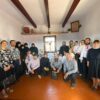 Memorial house of romanian elder Sofian Boghiu Consecrated in his native Village
Memorial house of romanian elder Sofian Boghiu Consecrated in his native Village 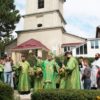 On the 14th Sunday after Pentecost, His Eminence Metropolitan Vladimir celebrated the Divine Liturgy in the St. Nicolas Monastery, Dobrusa village, Soldanesti region
On the 14th Sunday after Pentecost, His Eminence Metropolitan Vladimir celebrated the Divine Liturgy in the St. Nicolas Monastery, Dobrusa village, Soldanesti region  Inauguration of the volume of articles presented at the National Scientific Conference “The Orthodox Church and the State: Faith and Knowledge”
Inauguration of the volume of articles presented at the National Scientific Conference “The Orthodox Church and the State: Faith and Knowledge” 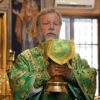 The 12th Sunday after Pentecost – kindness in God changes the world we live in
The 12th Sunday after Pentecost – kindness in God changes the world we live in 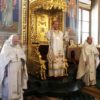 The 11th Sunday after Pentecost – loving our God and our neighbor
The 11th Sunday after Pentecost – loving our God and our neighbor 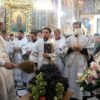 The Transfiguration of the Lord, celebrated in the Nativity of the Lord Cathedral in Chisinau
The Transfiguration of the Lord, celebrated in the Nativity of the Lord Cathedral in Chisinau 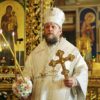 His Eminence Metropolitan Vladimir celebrates 65th anniversary
His Eminence Metropolitan Vladimir celebrates 65th anniversary  Divine Service at the St. Theodore of Tyre Monastery (Ciuflea) in Chisinau, and congratulation of Archimandrite Nicolae (Rosca), the Monastery’s confessor-administrator, on the 50th anniversary.
Divine Service at the St. Theodore of Tyre Monastery (Ciuflea) in Chisinau, and congratulation of Archimandrite Nicolae (Rosca), the Monastery’s confessor-administrator, on the 50th anniversary.  The Tenth Sunday after Pentecost: Divine Liturgy in the Nativity of the Lord Cathedral in Chisinau
The Tenth Sunday after Pentecost: Divine Liturgy in the Nativity of the Lord Cathedral in Chisinau 
